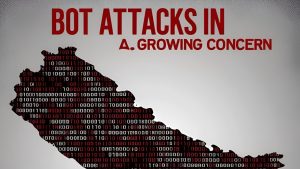Bot Attacks in Nepal: A Growing Concern
In recent years, Nepal has seen a significant rise in bot attacks, which have become a major concern for businesses, individuals, and the government. Bot attacks are a type of cyber attack where an attacker uses automated software programs, known as bots, to perform malicious activities such as data theft, denial of service, and spreading malware.
What are Bot Attacks?
Bot attacks are a type of cyber attack that involves the use of automated software programs, known as bots, to perform malicious activities. These bots can be programmed to perform a variety of tasks, including:
• Data theft: Bots can be used to steal sensitive data such as login credentials, credit card numbers, and personal identifiable information.
• Denial of service: Bots can be used to flood a website or network with traffic, making it unavailable to legitimate users.
• Spreading malware: Bots can be used to spread malware, such as viruses, Trojan horses, and ransomware.
Types of Bot Attacks
There are several types of bot attacks, including:
• Brute force attacks: These attacks involve the use of bots to try different combinations of usernames and passwords to gain unauthorized access to a website or network.
• DDoS attacks: These attacks involve the use of bots to flood a website or network with traffic, making it unavailable to legitimate users.
• Scraping attacks: These attacks involve the use of bots to extract data from a website or database.
Impact of Bot Attacks in Nepal
Bot attacks have had a significant impact on businesses and individuals in Nepal. Some of the consequences of bot attacks include:
• Financial loss: Bot attacks can result in significant financial losses for businesses and individuals.
• Reputation damage: Bot attacks can damage the reputation of a business or individual, making it harder to attract customers and investors.
• Data breach: Bot attacks can result in the theft of sensitive data, which can be used for malicious purposes.
How to Protect Yourself from Bot Attacks
There are several steps you can take to protect yourself from bot attacks:
Use Strong Passwords
Using strong passwords is one of the most effective ways to prevent bot attacks. A strong password should be at least 12 characters long and include a combination of uppercase and lowercase letters, numbers, and special characters.
Enable Two-Factor Authentication
Two-factor authentication adds an extra layer of security to your online accounts by requiring you to enter a verification code sent to your phone or email in addition to your password.
Keep Software Up-to-Date
Keeping your software up-to-date is crucial in preventing bot attacks. Regularly update your operating system, browser, and other software to ensure you have the latest security patches.
Use Anti-Bot Software
Anti-bot software can help detect and prevent bot attacks. These software programs use machine learning algorithms to identify and block suspicious traffic.
Conclusion
Bot attacks are a growing concern in Nepal, and it’s essential to take steps to protect yourself from these cyber threats. By using strong passwords, enabling two-factor authentication, keeping software up-to-date, and using anti-bot software, you can significantly reduce the risk of bot attacks.
